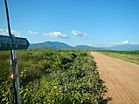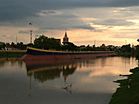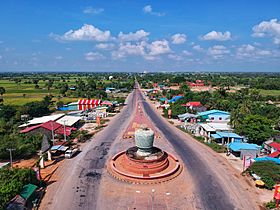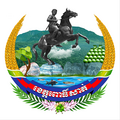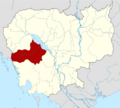Pursat province facts for kids
Quick facts for kids
Pursat (pho ti sat)
ពោធិ៍សាត់
|
||
|---|---|---|
|
Province
|
||
| Pursat Province ខេត្តពោធិ៍សាត់ |
||
|
||
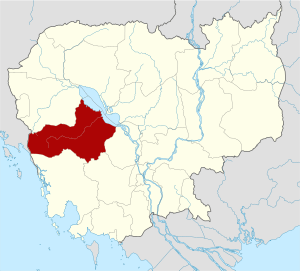
Map of Cambodia highlighting Pursat
|
||
| Country | ||
| Provincial status | 1907 | |
| Capital | Pursat | |
| Area | ||
| • Total | 12,692 km2 (4,900 sq mi) | |
| Area rank | 4th | |
| Population
(2024)
|
||
| • Total | ||
| • Rank | 15th | |
| • Density | 33/km2 (90/sq mi) | |
| • Density rank | 20th | |
| Time zone | UTC+07:00 (ICT) | |
| Dialing code | +855 | |
| ISO 3166 code | KH-15 | |
| HDI (2017) | 0.551 medium |
|
Pursat (Khmer: ពោធិ៍សាត់) is a province in Cambodia. It is located in the western part of the country. Pursat shares borders with Battambang province to the north, the Tonlé Sap lake, Kampong Chhnang province, Kampong Speu province, Koh Kong province, and East Thailand.
This province sits between the large Tonle Sap lake and the northern part of the Cardamom Mountains. The Pursat River flows through the province, starting in the Cardamom Mountains in the west and ending in the Tonle Sap in the east.
Pursat is the fourth largest province in Cambodia by land area. However, it ranks 15th in population. You can reach Pursat by National Highway 5, by boat, or by train. The capital city, also called Pursat town, is about 174 kilometers northwest of Cambodia's capital, Phnom Penh. It is also 106 kilometers southeast of Battambang.
Pursat is home to Wat Bakan, which is one of Cambodia's oldest and most sacred Buddhist temples. The province also hosts an annual event called the River Run Race. This race includes 5 km and 10 km distances for both men and women, including those who use wheelchairs. Since it started in 2007, it has become the second-largest race of its kind in Cambodia.
Contents
Meaning of the Name
The name Pursat comes from the Khmer language. Poŭthĭsăt (ពោធិ៍សាត់) means "floating banyan."
The word Poŭthĭ- (ពោធិ៍) comes from the Sanskrit and Pali word bodhi. This is the name of the tree where the Buddha became enlightened. The second part, -săt (សាត់), comes from the Khmer word rôsăt (រសាត់), which means "to float."
Geography and Nature
The geography of Pursat includes many different natural areas. These range from thick forests in the mountains to flat, fertile plains. The province also includes part of the Tonle Sap lake basin.
About 58% of Pursat is covered by forests. The tall Cardamom Mountains are in the west and southwest of the province. They run along the border with Thailand and the coast. The land gently slopes towards the northeast. This area opens into wide plains that continue into Battambang province. Many of Cambodia's rice crops are grown in these plains.
The Pursat River flows in this direction, emptying into the Tonle Sap lake. The lake forms Pursat's eastern border. Pursat is one of nine provinces that are part of the Tonle Sap Biosphere Reserve. This reserve helps protect the unique environment around the lake.
Religions in Pursat
Religion in Pursat (2019 census) Buddhism (96.9%) Islam (3.0%) Christianity (0.1%) Animism and Other religions (0%)
The main religion in Cambodia is Theravada Buddhism. More than 96.9% of the people in Pursat follow Buddhism. There are also communities of Cham people who have practiced Islam for hundreds of years. A small number of people in the province follow Christianity.
Economy and Industries
Thmada Development
Investors from China have put a lot of money into building a new city. This city is in Thmada, a village near the border in Veal Veang District. The new town is being built in five stages. By 2019, about 80% of the first stage was finished. This included 1,000 apartments, a fancy hotel, restaurants, and other businesses. The project was expected to be fully completed by 2025.
Agarwood Production
The climate and geography of Pursat are perfect for a type of tree called Aquilaria. These trees are important because they produce a special wood called agarwood. Agarwood is formed when the Aquilaria tree gets infected by a certain mold. This wood has a very unique and pleasant smell.
In the past, there was a lot of wild agarwood in Pursat's forests. People highly valued these trees for their distinct scent. The wood was often given as gifts to the royal family and important officials. Agarwood from Pursat was once the most valuable and sought-after type. In the early 1970s, "oud Cambodi" oil was very popular. People believed it had special effects on the mind and emotions.
However, too many wild agarwood trees were cut down. Because of this, Aquilaria trees are now listed as an endangered species. Projects are now working to grow these trees on farms. They are also trying to infect them with the mold on purpose. This helps produce agarwood in a way that protects the wild trees.
In 2015, a Cambodian official signed an agreement with a company from Singapore. This agreement allowed the company to access six million mature Aquilaria trees. They planned to treat these trees to produce agarwood in a sustainable way.
Administrative Divisions
Pursat province is divided into six districts and one municipality. These areas are further split into 51 smaller communities called communes.
| ISO code | District | Khmer |
|---|---|---|
| 15-01 | Bakan | ស្រុកបាកាន |
| 15-02 | Kandieng | ស្រុកកណ្តៀង |
| 15-03 | Krakor | ស្រុកក្រគរ |
| 15-04 | Phnum Kravanh | ស្រុកភ្នំក្រវាញ |
| 15-05 | Pursat Municipality (formerly Sampov Meas) | ក្រុងពោធិ៍សាត់ (អតីត ស្រុកសំពៅមាស) |
| 15-06 | Veal Veang | ស្រុកវាលវែង |
| 15-07 | Talou Senchey | ស្រុកតាលោសែនជ័យ |
Images for kids
See also
 In Spanish: Provincia de Pursat para niños
In Spanish: Provincia de Pursat para niños


